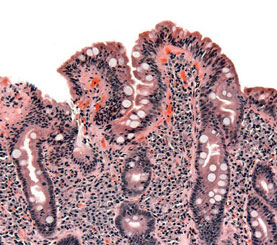For tobacco dependent, pharmacotherapy is the best medicine
Evidence is mounting that most smokers will require some sort of pharmacotherapeutic intervention to help them quit. Experts parse out prescriptions, but don't discount behavioral strategies for quitting.
It's the best of times and the worst of times for treating tobacco dependence, according to David Sachs, ACP Member, founder of the Palo Alto (California) Center for Pulmonary Disease Prevention.
“It's the best, because we've never had more tools to treat tobacco dependence. And it's the worst because most physicians have no idea how to treat patients (for dependence),” Dr. Sachs said last October during a press conference at the American College of Chest Physicians (ACCP) 2008 meeting.

Increasingly, experts like Dr. Sachs recommend that primary care physicians focus their efforts on medication management. That's because evidence is mounting that most smokers will require some sort of pharmacotherapeutic intervention to help them quit, said John Hodgkin, FACP, medical director of the Center for a Smoke-Free Life at St. Helena Hospital in St. Helena, Calif.
“In the last decade, it has become apparent to people who run stop-smoking programs that it is harder to use non-medication strategies to help people successfully stay off cigarettes,” Dr. Hodgkin said. “The problem isn't quitting, but staying quit.”
This is not to say that behavioral strategies for quitting tobacco aren't important. Experts agree that physicians should refer patients to local and national tobacco control resources (see sidebar) to learn coping skills that will supplement treatment with medication.
“Most community programs are good programs that provide a lot of helpful information on why it's harmful to smoke, how to deal with triggers, and how to stay healthy while quitting. But at some point, these programs usually tell patients to talk to their doctors, because medications have been shown to improve long-term success rates,” Dr. Hodgkin said. “So doctors need to be ready.”
Severity of dependence increasing
Patients who are trying to stop using cigarettes now are significantly more nicotine-dependent than they were just 15 years ago, according to a study Dr. Sachs presented at the ACCP 2008 conference. Specifically, his study found that nicotine-dependence severity has increased 12% between 1989-2006, and that 75% of patients seeking treatment are highly dependent.
“Most of your tobacco-dependent patients will be highly nicotine dependent, and over-the-counter medications alone will not work for them,” Dr. Sachs said. “These patients need individualized treatment and attention.”
A severely nicotine-dependent patient may not respond to standard treatment, which is based on data and treatment concepts from 15 years ago, Dr. Sachs said. Doses may need to be larger; medications may need to be combined. The physician may also need to put more emphasis on minimizing withdrawal symptoms, he said.
Indeed, patients often get frustrated because they try to quit by using nicotine patches according to label instructions when, in fact, their addiction is too strong for the recommended dose, Dr. Hodgkin said. As well, most patients who use the patch also need to use short-acting nicotine rescue products, like an inhaler or lozenges, for breakthrough cravings, even though the instructions warn against using these other products, he said.
“The majority of smokers today need more than one large patch a day, although the package inserts say never to use more than one per day. So they try it, they get horribly uncomfortable, and they go right back to smoking,” Dr. Hodgkin said.
How to treat
To choose the right medications, physicians first need to determine their patient's level of nicotine dependence by using a measurement like the Fagerstrom Test for Nicotine Dependence, Dr. Sachs said. The test is online.
“If you don't measure nicotine dependence in a patient, you won't know how to treat him or her,” Dr. Sachs said. “It would be like trying to treat high blood pressure without knowing the actual blood pressure.”
It also helps to know what a patient has used in the past to quit. If, for example, a patient used a medication and had a partial response to it, you may use that same therapy but adjust the dose, said Richard Hurt, MD, director of the Nicotine Dependence Center at Mayo Clinic in Rochester, Minn.
The next step is determining which medications to prescribe to an individual patient. Three Pfizer-supported studies in the July 5, 2006 Journal of the American Medical Association found varenicline (Chantix) to be superior to bupropion (Wellbutrin) and placebo in helping patients quit smoking, though the side effects were more intense as well.
Dr. Hurt, who was once on a Pfizer Scientific Advisory Board, said his clinic's approach is to talk through the evidence and side effects of each medication with patients, and then determine treatment together.
“I tell them that with bupropion the main side effect is dry mouth and sleep disturbance. The nicotine patch can irritate your skin after the fourth or fifth week, and cause vivid dreams. Varenicline can cause nausea and vivid dreams. I go through the side effects like this, and the ways we use one or more of these three drugs as our base,” Dr. Hurt said. “Then we talk about using a short acting nicotine replacement product like the nicotine inhaler, gum, nasal spray or lozenges that can be used to control cravings or urges. And then we decide what to do together.”
Different strategies may be more effective for different sorts of patients. A study in the April 7, 2009 Annals of Internal Medicine found that smokers with chronic illness had the most success quitting when they used triple pharmacotherapy: nicotine patch, nicotine oral inhaler and bupropion (Wellbutrin).
The combination group had an abstinence rate at 26 weeks of 35%, compared with 19% for the patients who received only the patch for a 10-week tapering course. The median time to relapse was also longer: 65 days in the combination group compared with 23 days in the patch group. Advantages of the combined regimen include the fact that tobacco withdrawal is attacked through different mechanisms of action, and the use of an inhaler gives the smoker immediate control over cravings, the authors concluded.
The importance of follow-up
Following up with patients is critical, especially in the first few months after a quit attempt, Dr. Hodgkin said. That's because the biggest percentage of relapse occurs in the first three to six months, he said.
“If a person can get to 12 months of abstinence, there is a good chance he or she won't relapse,” Dr. Hodgkin said.
Dr. Hurt strives to touch base with his patients within the first week or two after starting pharmacotherapy, in case adjustments need to be made. Some patients may find, for example, that they can't tolerate the taste of lozenges. Others may find themselves wanting something to do with their hands, so they need an inhaler that looks like a cigarette.
“A follow-up phone call is fine and easy to do, though you probably need to schedule a time that both of you will show up for the call. If you use the nicotine patch and the patient hasn't stopped smoking within the first two weeks, the chances of stopping are zero. So you need to check in on that early,” Dr. Hurt said. “Likewise, you need to make sure the dose response to oral medications is optimal.”





